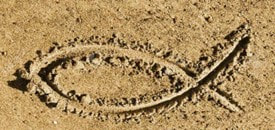|
LORD JESUS CHRIST, SON OF GOD SAVIOR, HAVE MERCY ON ME—A SINNER Several weeks ago, I wrote encouraging everyone to pray more and specifically to pray using the “Jesus Prayer.” Since then, I have been asked several times for scriptural references to the prayer. Additionally, in the past several weeks as I have prepared and led the Icon class during the Adult Education segment on Sunday morning, I have been asked for more detail about the ICTHYS: the fish symbol used by Christians to communicate in the first century. As there is a distinct relationship between these two very different Christian actions, I will attempt to relate them today and finish up next week. First, the Fish! During the first century under several Roman rulers, Nero (37-68), Vespasian (69-79), and Domitian (81-96), Christians were seen as the cause of social unrest and economic decline, pawns in political popularity contests, popularists of rebellion, and competitors to Roman authority—in short, they were convenient ‘scape goats’ for all that ails, plus they were just fun to hate. If Christians were to remain faithful and meet to share devotion and praise the Lord, they would need a system that would identify them to each other, but not to the world. They soon developed a secret symbol. When two people would meet, say a traveler and a ‘towny,’ after several minutes of conversation, one of them would take his foot and draw an arc on the ground. If the other person were a Christian, he would take his foot or finger and draw another arc, completing the symbol of the fish. Then they would take turns putting the five Greek letters IXOUS (ΙΧΘΥΣ) inside the fish. This word is pronounced “ick-this,” and is the normal word used in the gospels for "fish" (Matthew 7:10, 14:17, and others). The ichthys in Greek, I-X-O-U-S, forms an acrostic. An acrostic, LitCharts online dictionary tells us is, “… is a piece of writing in which a particular set of letters—typically the first letter of each line, word, or paragraph—spells out a word or phrase with special significance to the text.” The early Christians recognized that the word ichthys formed an acrostic for Jesus Christ Son of God, Savior. This combined with the simple, seemingly random “line in the sand” movement, secured the fish as a perfect Christian symbol. So, what is the acrostic and where did it come from? IXOUS (ΙΧΘΥΣ) Ι represents Iesous (Ιησους), which is the Greek word for "Jesus." An angel of the Lord appeared to Joseph and told him that his fiancée, Mary, "shall bring forth a son, and thou shalt call His name JESUS: for He shall save His people from their sins" (Matthew 1:21). The Hebrew form of His name is Yehoshua (Joshua), which was shortened to Yeshua and transliterated from Greek as Jesus. IXOUS (ΙΧΘΥΣ) Χ stands for Xristos (Χριστος), or "Christ," meaning "anointed." Jesus is God's "Anointed One." When Jesus was born, the angels announced Him to the shepherds as "Christ the Lord" (Luke 2:11). Peter declared, "Thou art the Christ, the Son of the living God" (Matthew 16:16). The Hebrew form of "Christ" is "Messiah." IXOUS (ΙΧΘΥΣ) Θ stands for Theos (Θεου) which is translated "God." Jesus the Messiah is none other than the eternal God revealed in human flesh (John 1:1-3; Colossians 1:15-20; 2:9). In Paul's letter to Titus, he proclaims the divinity of Jesus Christ: "the great God and our Savior, Jesus Christ" (Titus 2:13). IXOUS (ΙΧΘΥΣ) Υ represents Uios (Υιος) which means "Son." Jesus is "the only begotten Son" of God (John 3:16). “In the past God spoke to our ancestors through the prophets at many times and in various ways, but in these last days he has spoken to us by his Son, whom he appointed heir of all things, and through whom also he made the universe.” (Hebrews 1:1-3). IXOUS (ΙΧΘΥΣ) Σ stands for Soter (Σωτηρ), meaning "Savior." "For unto you is born this day in the city of David a Savior, which is Christ the Lord" (Luke 2:11). He is the promised "Savior of the world" (John 4:42). The idea is deliverance, a saving from disaster, rescue from a hopeless situation, and breaking the chains of bondage. Indeed, the Bible tells us, "Neither is there salvation in any other: for there is none other name under heaven given among men, whereby we must be saved." (Acts 4:12). So, to start us off answering these questions, the use of ICTHYS as an acrostic of Jesus Christ Son of God Savior, is based on many different scriptural references (there are still others as well). It is easy to see the connection between the Jesus Prayer and the ICTHYS as, though they are from different times and are created by different means, they both use the same source material: the biblical witness. Next week, we will take a look at the second half of the Jesus Prayer, …have mercy on me, a sinner, and learn how this somewhat offensive sentence, is actually an honest proclamation of self-awareness in the light of divine love. ICTHYS
Fr. Bill+
0 Comments
Leave a Reply. |
AuthorFather Bill Burk† Archives
July 2024
Categories |
Proudly powered by Weebly



 RSS Feed
RSS Feed